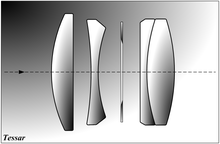Tessar
 |
|
| Introduced in | 1902 |
|---|---|
| Author | Paul Rudolph |
| Construction | 4 elements in 3 groups |
| Aperture |
f/6.3 (1902) f/4.5 (1917) f/2.8 (1930, by Willy Merté) |
The Tessar is a famous photographic lens design conceived by the German physicist Paul Rudolph in 1902 while he worked at the Zeiss optical company and patented by Zeiss in Germany; the lens type is usually known as the Zeiss Tessar.
A Tessar comprises four elements in three groups, one positive crown glass element at the front, one negative flint glass element at the center and a negative plano-concave flint glass element cemented with a positive convex crown glass element at the rear.
Despite common belief, the Tessar was not developed from the 1893 Cooke triplet design by replacing the rear element with a cemented achromatic doublet. In fact, Paul Rudolph designed the Anastigmat with two cemented doublets in 1890. In 1899, he separated the doublets in the Anastigmat to produce the four-element, four-group Unar lens. In 1902, he realized that reversing the two rear elements of the Unar and returning to a cemented doublet would improve performance; he named the result "Tessar", from the Greek word τέσσερα (téssera, four) to indicate a four-element design.
Early Tessar designs by Paul Rudolph allowed a maximum aperture of f/6.3. Later development allowed an aperture of f/4.5 by 1917. In 1930, Ernst Wanderslab and Willy Merté of Zeiss developed Tessar lenses with apertures of f/3.5 and f/2.8.
Tessar are frequently found in mid-range cameras, as they can provide a very good optical performance at a reasonable price, and are often quite compact. They are also frequently used in photographic enlargers, as they provide more contrast than many competing lens designs due to the limited number of air-to-glass surfaces.
All lenses can be focused by moving the lens assembly towards or away from the film ("unit focusing"), and the Tessar is no exception. Unit-focusing Tessars were used on higher-end cameras such as the Contaflex Super B, Rolleiflex TLR, and larger-format plate cameras such as the Maximar.
Some lenses, including Tessars, can be focused by moving lens elements relative to each other; this usually worsens optical performance to some extent, but is cheaper to implement. As the front element of the Tessar has three times the power of the whole lens, it must be moved one-third of the distance that the whole lens would need to move to focus at the same point. The large airspace between the first and second elements allows focusing by moving the front element only; as the displacement is small compared with the airspace, the adverse effect on image performance is not severe. The front-element-focusing Tessar, cheaper than a unit-focusing lens, was widely used in many midrange Zeiss Ikon cameras.
...
Wikipedia
